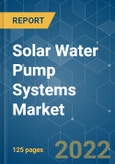The solar water pump systems market is expected to register a CAGR of more than 5% during the forecast period, 2022-2027. The COVID-19 outbreak in Q1 of 2020 was moderately impacted, thus resulting in disruptions of importing solar cells and modules from Chinese companies. Factors such as increasing demand for clean energy pump systems and the supportive government incentives and tax rebates over the installation of solar water pump systems are expected to drive the market during the forecast period. However, the high installation costs and the limited specialized service personnel are restraining the market's growth.
The Solar Water Pump Systems Market is moderately fragmented. The key players in the market include Bright Solar Limited, C.R.I. Pumps Private Limited, KSB Limited, Shakti Pumps (India) Ltd, and Tata Power Company Limited.
This product will be delivered within 2 business days.
Key Highlights
- The submersible pump type segment, designed to pump water from deeper wells, where surface pumps cannot be used, is expected to drive the market during the forecast period.
- Powering Agriculture: An Energy Grand Challenge for Development (PAEGC) program aims to identify and support the development and deployment of clean energy solutions for increasing agriculture productivity in developing countries. The program is expected to create opportunities for the market studied.
- Asia-Pacific holds the largest market share and is also expected to be the fastest-growing region, owing to the massive increase in solar water pump system installations in countries like China and India.
Key Market Trends
Submersible Pump Type Segment to Dominate the Market
- Submersible pumps are located deep below the ground level, and their suction head is beyond 10 meters deep. Hence, it can lift water from significantly deeper sources. Government subsidies to farmers and solar pump manufacturers, especially in emerging economies of Asia-Pacific, are expected to drive the solar water pump systems market in the forecast period.
- Irrigation is a major application area for solar pumps in India. This makes India a land of huge market opportunities for solar submersible pumps. The Indian government had set ambitious targets for expanding the country’s renewable energy generating capacity. In 2010, the country launched the Jawaharlal Nehru National (JNN) Solar Mission.
- The Ministry of New and Renewable Energy (MNRE), India, outlined the Solar Pumping Program for irrigation and drinking water, which sought to promote the adoption of solar pumps over the next five years. Due to such government support, the submersible pumps market in India is expected to provide ample opportunities for pump manufacturers during the forecast period.
- Moreover, the submersible solar pump systems are used majorly for irrigation and supply of potable water. The oil and gas sector is also embracing these pumps for chemical injection, as these pumps do not emit greenhouse gases, hence promulgating the growth of solar power pump systems.
- In March 2021, the Indian government inaugurated a 41 HP (50 KW) solar submersible carbon-neutral pump at Latoo, Kargil. The pump has a water lifting capacity at a direct head range of 130-160 meters that discharges water at 54 cubic meters per hour.
- Therefore, based on the mentioned factors above, the submersible pump type segment is expected to dominate the solar water pump systems market during the forecast period.
Asia-Pacific to Dominate the Market
- The Asia-Pacific region dominated the global market share and emerged as one of the largest solar pump markets. With inadequate power generation capacity and grid infrastructure for irrigation and community water supply facilities, solar water pumps have a good chance of replacing conventional pumps.
- The number of solar pumps in India has been increasing since the Jawaharlal Nehru National Solar Mission scheme started in 2014, with about 130,000 pumps installed. In February 2019, Pradhan Mantri Kisan Urja Suraksha evam Utthaan Mahabhiyan (PM-KUSUM) Scheme was launched by the Ministry of New and Renewable Energy (MNRE) for setting up subsidized solar pumps and distributed solar power plants across the country. It is one of the biggest initiatives in the world to provide clean energy to more than 3.5 million farmers across India.
- The increasing power demand and need for drinking safe water have led to the deployment of solar water pumps in Bangladesh. Infrastructure Development Company Ltd (IDCOL), a financing company in Bangladesh, tried and tested the ownership model. The company uses micro-finance to enhance rural households' ability to afford capital-intensive solar home systems.
- Moreover, increasing awareness of the potential benefits of this technology has compelled several countries to accelerate the deployment of solar water pumps, with Bangladesh setting a target of 50,000 solar pumps by 2025.
- The PM-KUSUM scheme's Component B also aims to install 1.75 million standalone solar-powered agriculture pumps of individual capacity up to 7.5 HP by 2022, which is expected to drive the market in the Asia-Pacific region.
- Therefore, with various government initiatives launched by the countries like China and India, the Asia-Pacific region is expected to dominate the solar water pump systems market during the forecast period.
Competitive Landscape
The Solar Water Pump Systems Market is moderately fragmented. The key players in the market include Bright Solar Limited, C.R.I. Pumps Private Limited, KSB Limited, Shakti Pumps (India) Ltd, and Tata Power Company Limited.
Additional Benefits:
- The market estimate (ME) sheet in Excel format
- 3 months of analyst support
This product will be delivered within 2 business days.
Table of Contents
1 INTRODUCTION
4 MARKET OVERVIEW
5 MARKET SEGMENTATION
6 COMPETITIVE LANDSCAPE
Companies Mentioned (Partial List)
A selection of companies mentioned in this report includes, but is not limited to:
- Advanced Power Inc.
- Bright Solar Limited
- C.R.I. Pumps Private Limited
- Kirloskar Brothers Limited
- KSB Limited
- Bernt Lorentz GmbH
- Shakti Pumps (India) Ltd
- Tata Power Company Limited
Methodology

LOADING...








